
SEE JANE RANCH
Cattle rancher serves up beefy insights to connect rural and urban communities.
By Coleman Cornelius | July 1, 2022
SHE WAS DUBIOUS THAT COWS AND MOUNTAIN BIKES COULD COEXIST. Yet, Janie VanWinkle knew one thing: Beginning in 2015, she was at the table for years of discussion and debate about a new bike trail, and her face time with fellow Grand Valley community members was a win for the fourth-generation cattle rancher.
The topic was the proposed Palisade Plunge, a 32-mile, point-to-point mountain bike trail that would wend over the lip of Grand Mesa, the massive landmark rising above Grand Junction and the town of Palisade on Colorado’s Western Slope. The trail would descend 6,000 feet to its picturesque namesake on the Colorado River, a town known for peach orchards and vineyards. Advocates expected the Palisade Plunge to attract riders from near and far; they could infuse an estimated $5 million into the local economy each year.
VanWinkle added to planning the cautionary perspective of a rancher intimately familiar with the land – gained because VanWinkle Ranch leases mesa terrain for cattle grazing from the city of Grand Junction, one of four government entities that own Grand Mesa land. The new trail would traverse part of that leased property. VanWinkle and her family shared their concerns about potential impacts: on the watershed, on elk habitat, on hunting, on their cattle, and, generally speaking, on a drought-stressed, high-desert ecosystem that had been relatively shielded from human intrusion. Ultimately, recreation and business interests prevailed in trail development. Yet, VanWinkle’s voice was heard: Her input influenced trail routing and informative signage. And, with uncommon cooperation among public agencies, landowners, and community members, the Palisade Plunge was constructed and opened in July 2021. VanWinkle was a speaker at the ribbon-cutting.
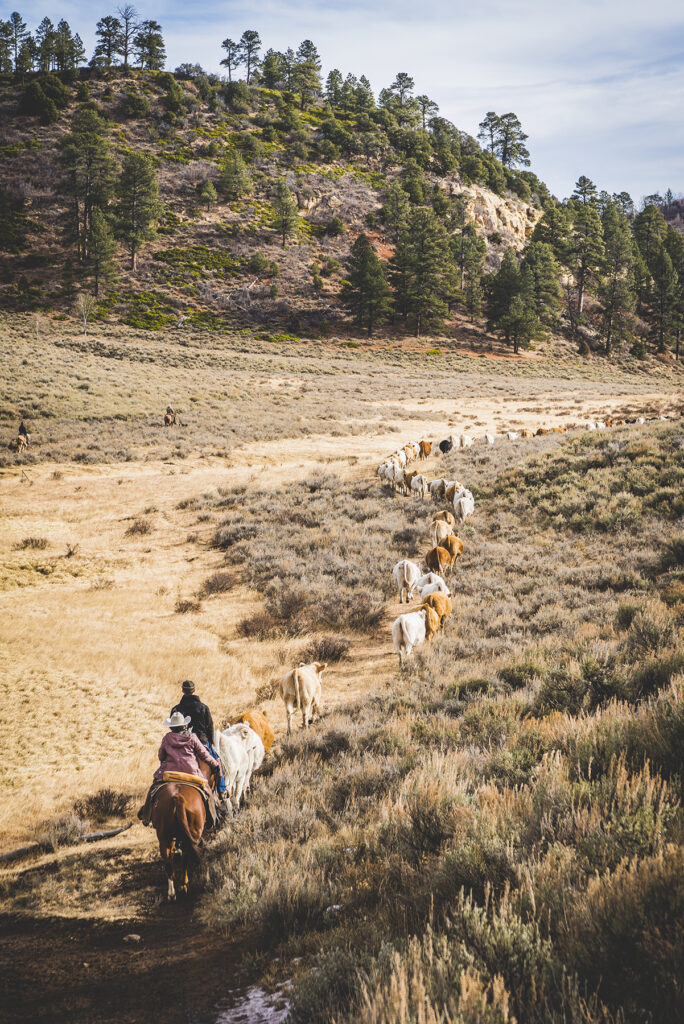
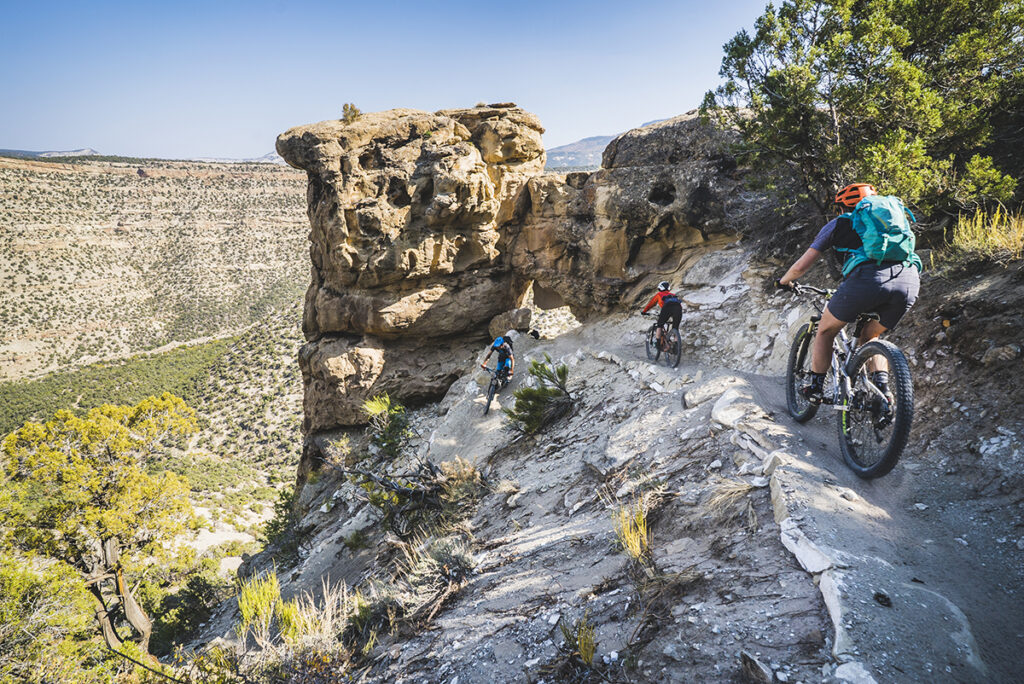
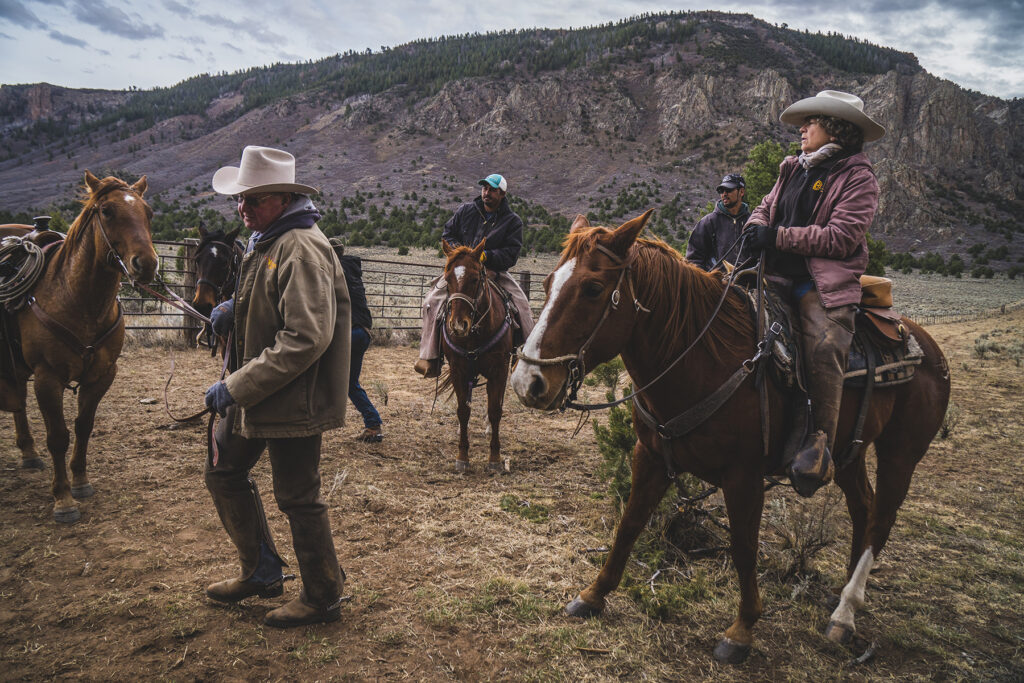
Left: The VanWinkle family brings in cattle from national forest land. Top right: Janie VanWinkle has been part of community discussions about the Palisade Plunge mountain biking trail. Bottom right: Howard and Janie VanWinkle prepare to move cattle with their ranch crew. Photography: Devon Balet
Top: The VanWinkle family brings in cattle from national forest land. Middle: Janie VanWinkle has been part of community discussions about the Palisade Plunge mountain biking trail. Bottom: Howard and Janie VanWinkle prepare to move cattle with their ranch crew. Photography: Devon Balet
Her involvement in the Palisade Plunge confirmed the value of agricultural perspectives in public land-use planning and made VanWinkle a go-to adviser on other Western Slope projects. Her contribution was epitomized by a discussion VanWinkle had in Fall 2018 with a mountain biker who accompanied her family as they gathered cattle from summer grazing in Uncompahgre National Forest. The VanWinkles, on horseback, covered 12 miles with their mountain biking guest, Devon Balet. He is a Grand Junction adventure photographer who supported development of the Palisade Plunge.
“You know what we always do after a ride like this?” Balet asked VanWinkle during a break on the roundup. “We have burgers and beer – and I hadn’t thought much about where burger comes from until now.”
For VanWinkle, the moment underscored the power of food as a connection point, often for people with different views. “We all have something in common, and that’s the need for safe, affordable, nutritious food,” she said, while touring VanWinkle Ranch by utility terrain vehicle on a blustery spring day. “This is where food comes from, and that’s why we have to be sustainable – economically, environmentally, and socially. It all ties together. We can’t do what we do if we don’t do all three.” VanWinkle discussed her ranching philosophy to the song of a meadowlark and the call of a killdeer. A chukar flushed from nearby sagebrush. Dozens of white Charolais and Charolais crossbred calves lazed in the sun, the newest in the ranch herd of nearly 600 cattle.

Howard and Janie VanWinkle check on newborn Charolais calves at their ranch near Grand Junction. Photo: Aaron Ontiveroz / The Denver Post via Getty Images
VanWinkle grew up on a family ranch in Unaweep Canyon, southwest of Grand Junction. She later attended Colorado State University, graduating with a bachelor’s degree in agricultural education in 1983. But she didn’t make her career teaching in school classrooms. Instead – in addition to running retail businesses and her cattle ranch – VanWinkle dedicated herself to educating the public and policymakers about food animal production.
She rose to prominence in the role while serving during 2020-2021 as board president of the Colorado Cattlemen’s Association, only the third woman to hold the top board of directors position in the organization’s 155-year history. VanWinkle’s ongoing leadership is significant in part because beef is the No. 1 agricultural commodity in Colorado, generating nearly $4 billion in revenue each year, according to the U.S. Department of Agriculture. That represents more than 50 percent of total cash receipts from crops and livestock in Colorado, making beef the heavyweight in agriculture and a powerhouse industry in the state.
Delivering insights about food production is a top goal of both CSU Spur and the Colorado Cattlemen’s Association – and a key reason the state’s leading beef-industry organization soon will move its offices from Arvada back to the historic Livestock Exchange Building at the National Western Center, where it was housed for many years. Association offices will neighbor Terra at CSU Spur, a building for public education, research, and community outreach on the topics of food and agriculture. VanWinkle and others in the Colorado Cattlemen’s Association envision the renovated Livestock Exchange Building and nearby facilities as a newly invigorated industry hub that invites urban audiences to learn about animal agriculture.
“In agriculture, we have one macro challenge and it’s that food production directly involves less than 2 percent of the U.S. population. So we’re a very small percentage of people who have firsthand experience with agriculture. That is causing us many challenges when it comes to public perceptions and policies,” said Terry Fankhauser, executive vice president of the Colorado Cattlemen’s Association. “We need to become more transparent, more open, and more welcoming. The National Western Center is the perfect venue to do that.”
The drought is so pervasive; it feels like it’s in your face all the time. This is conserving water, it’s producing food, and it’s making a difference with wildlife and the ecosystem – that’s a huge, big deal to me.”
— Janie VanWinkle, past president, Colorado Cattlemen's Association
For instance, Fankhauser noted, farm and ranch leaders actively adopt animal welfare and environmental conservation practices, topics of concern among many urbanites. And beyond producing food, farms and ranches provide open space and wildlife habitat widely valued by Colorado residents.
VanWinkle puts a face on these issues through her community efforts, industry work, and social media presence, making ranching more understandable and approachable, Fankhauser said. She won the 2021 Trailblazer Award from Denver Business Journal for such leadership. “Unless you connect with people in some way, you don’t have any sense of common ground,” Fankhauser said. “Having people like Janie out there talking about things helps get Colorado back to saying, ‘We need agriculture.’”
That describes the experience Balet had during the VanWinkle Ranch cattle roundup he joined. Balet had often ridden trails around the Uncompahgre Plateau on his mountain bike, but he had a different view riding alongside the ranch family. “The trail we were on had been built by Janie’s father and her grandfather. Being able to make that personal connection helped solidify the idea that there are many users out there, and there are many perspectives on public lands use. It was great to be able to make that connection with someone in the ranching community,” Balet said. “It helped me sit back and listen to other folks and consider their perspectives. I feel really fortunate to have been on that cattle drive.” Now, Balet buys ground beef direct from VanWinkle Ranch.
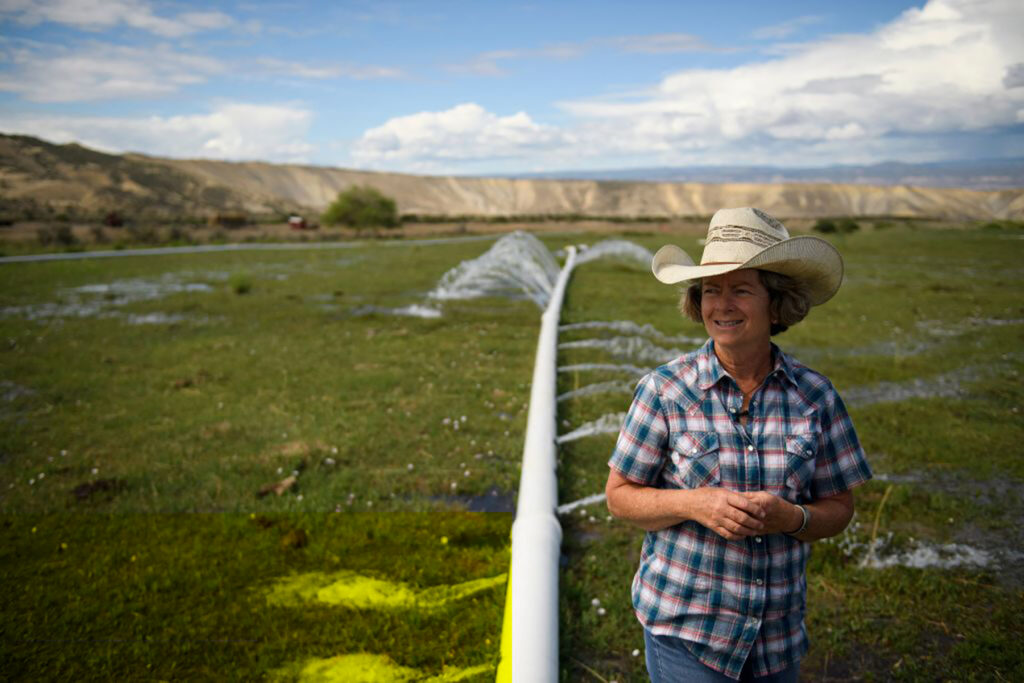
Janie VanWinkle discusses an irrigation system designed to conserve water on her arid ranchland. Photo: Patrick T. Fallon / AFP via Getty Images
From the time she was a ranch kid in canyon country, VanWinkle knew she wanted to raise Charolais cattle, a heavily muscled beef breed with a white hair coat. In the 1960s, her maternal grandfather had introduced Charolais cattle to the region. As a youngster in 4-H, Janie met a kindred spirit in her future husband, Howard.
But unlike some people from longtime ranching families, VanWinkle did not inherit land or cattle. Rather, she and Howard worked at a variety of Grand Junction businesses to earn a living while building their herd – Janie as manager of a Barnes & Noble bookstore and owner of a pizza shop, among other jobs, and Howard as a mechanic and owner of an auto repair shop. Howard was the first to transition to full-time ranching. And in 2015 – after 35 years working town jobs and building a ranch on the side – Janie joined her husband in running VanWinkle Ranch full time. They had finally realized their life goal. Along the way, the couple had their son, Dean, who works for the operation as a fifth-generation rancher.
“We were always going to ranch – there was never any question about that. The question was how. Usually, you either marry or inherit a ranch, and that didn’t work out for Howard,” VanWinkle, 61, said with a laugh. The couple live in Fruita and travel around Mesa County to tend cattle, mainly on leased parcels. The largest is a 12,000-acre tract owned by the city of Grand Junction, which partially covers the western flank and foot of Grand Mesa. Their cattle also pasture at a local gravel pit and wastewater treatment plant, and, during part of the year, graze by permit on national forest and Bureau of Land Management property.
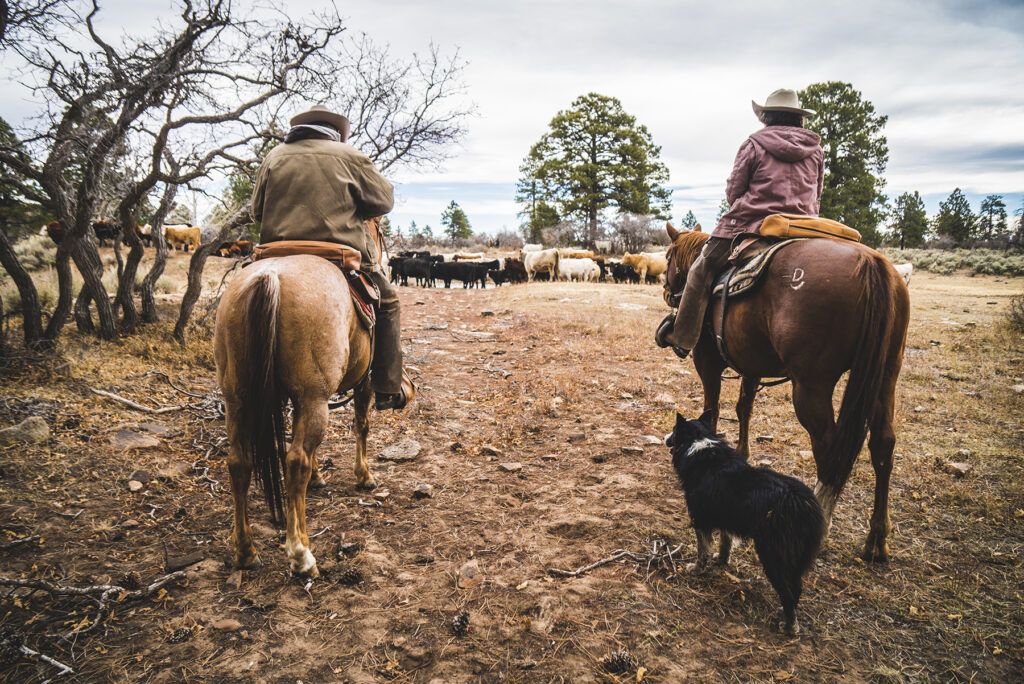
For 35 years, Howard and Janie VanWinkle worked other jobs as they built their cattle herd and finally transitioned to full-time ranching together. Photo: Devon Balet
The mix uniquely positions VanWinkle to interact with both city and country folk at a time when housing development, outdoor recreation, and other industries increasingly butt up against farming and ranching. Against this backdrop, VanWinkle looks for every opportunity to discuss food production, whether through frequent interviews with news media, by installing a sign on the Colorado Riverfront Trail about the benefits of cattle grazing, or with handouts, whipped from her handbag, noting that every cow in Mesa County annually contributes $600 to $800 to the economy. VanWinkle often describes the interconnections of land, livestock, and community – and her commitment to caring for all three.
Her concept starts with land, which, in the high desert, necessarily involves water. “The drought is so pervasive; it feels like it’s in your face all the time,” VanWinkle said. Standing on an oasis of irrigated pasture, she pointed to the top of Grand Mesa, at nearly 11,000 feet, an important source of runoff for the land below. To make the most of the water, VanWinkle Ranch secured a federal grant from the Natural Resources Conservation Service to install a high-efficiency irrigation system featuring a network of underground and surface piping. “This is conserving water, it’s producing food, and it’s making a difference with wildlife and the ecosystem – that’s a huge, big deal to me,” she said.
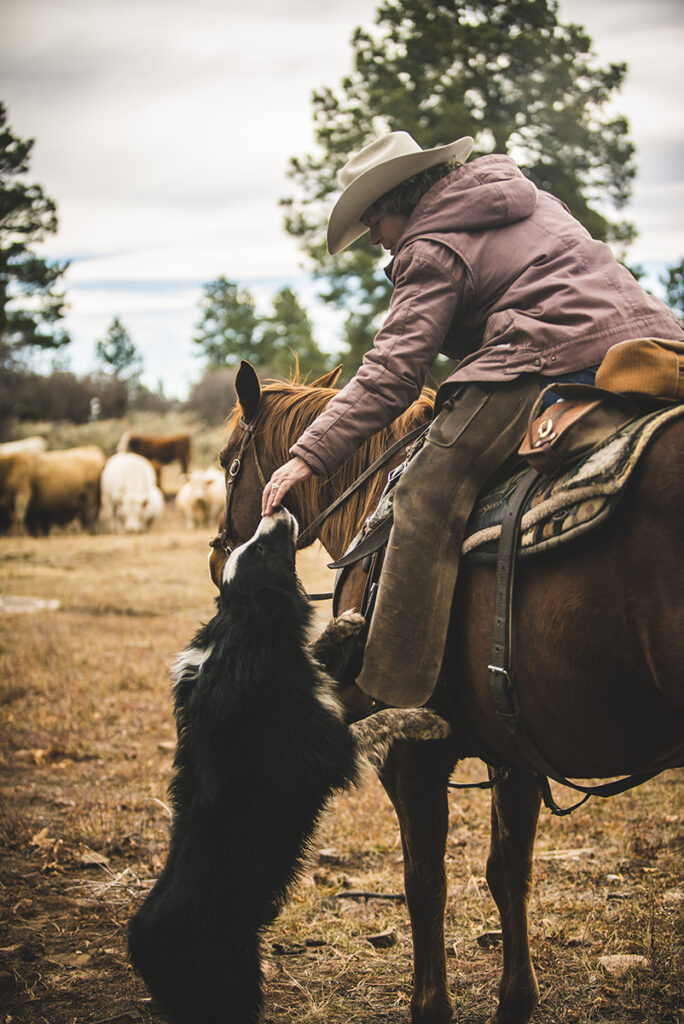
VanWinkle works cattle on horseback with her trusty dog, Kip. Photo: Devon Balet
North of the irrigated acreage, VanWinkle Ranch leases BLM ground for rotational cattle grazing, an on-again, off-again approach meant to protect, and even improve, soil and plant health. The ranch rests the arid ground for 18 months, then allows grazing for six weeks; rests it for three months, with grazing for another six weeks; then starts the cycle again. The approach, VanWinkle said, supports habitat for birds, lizards, bobcats, coyotes, mountain lions, deer, elk, and antelope. “It’s amazing how alive it is,” she said, looking over the starkly beautiful landscape. In recognition of such practices, Colorado Parks and Wildlife and the Colorado Cattlemen’s Association named VanWinkle Ranch 2019 Landowner of the Year.
Most VanWinkle Ranch income is derived from the sale of 8-month-old “feeder” or “stocker” cattle that have grown to roughly 650 pounds eating hay and forage on grazing ground – typically rugged terrain that could not be farmed for human food or livestock feed crops. From this grass-fed start, the cattle go to some of the nation’s largest feedlots, usually in northeastern Colorado, where they are fed a grain-based ration until reaching slaughter weight of about 1,400 pounds at 16 months to 18 months of age. The beef might ultimately reach markets across the country and around the world.
Yet, feeding a world of some 8 billion people often starts at home – in the local community, VanWinkle said. Her ranch sells USDA-inspected ground beef direct to consumers, charging $6 per pound for the locally raised product. Her customers include people across the economic spectrum, from owners of multimillion-dollar homes to single moms who set aside grocery money in envelopes each week. VanWinkle Ranch also has contracted with Food Bank of the Rockies to annually sell about 24,000 pounds of low-cost hamburger for distribution to people facing hunger and food insecurity in Mesa County. “In a significant way, people who need high-quality, nutritious food are getting it,” VanWinkle said of the partnership. “That’s really powerful to me.”
She noted many conversations about food revolve around terms that, at times, are used as nearly interchangeable buzzwords – “natural” and “organic,” for instance – and tend to pit specialty products against those that are conventionally produced. That’s a fallacy, VanWinkle said, acknowledging that many families cannot afford pricier niche products; yet, everyone needs safe, wholesome food.
“We’ve gotten so hung up about the ‘how’ of food production that we’ve forgotten the ‘why’ of feeding people,” she said. “It doesn’t need to be an either/or. We can have good environmental practices and large-scale food production. There’s a niche for everybody. It’s all about the ‘and.’”
Much of VanWinkle’s advocacy for agriculture is built on efforts to share sound information and listen to differing viewpoints, as was the case during discussions about the Palisade Plunge.
“Compromise is a big deal. Digging in your heels and saying ‘no’ is usually not very fruitful,” she said. “Agriculture has opportunities to connect with consumers and voters, we just need to see them as opportunities. The food connection and the outdoor connection are good opportunities.
“The most common ground,” she added, “is that on which we’re standing.”
ALUMNA IS FIRST WOMAN TO LEAD CATTLE ASSOCIATION
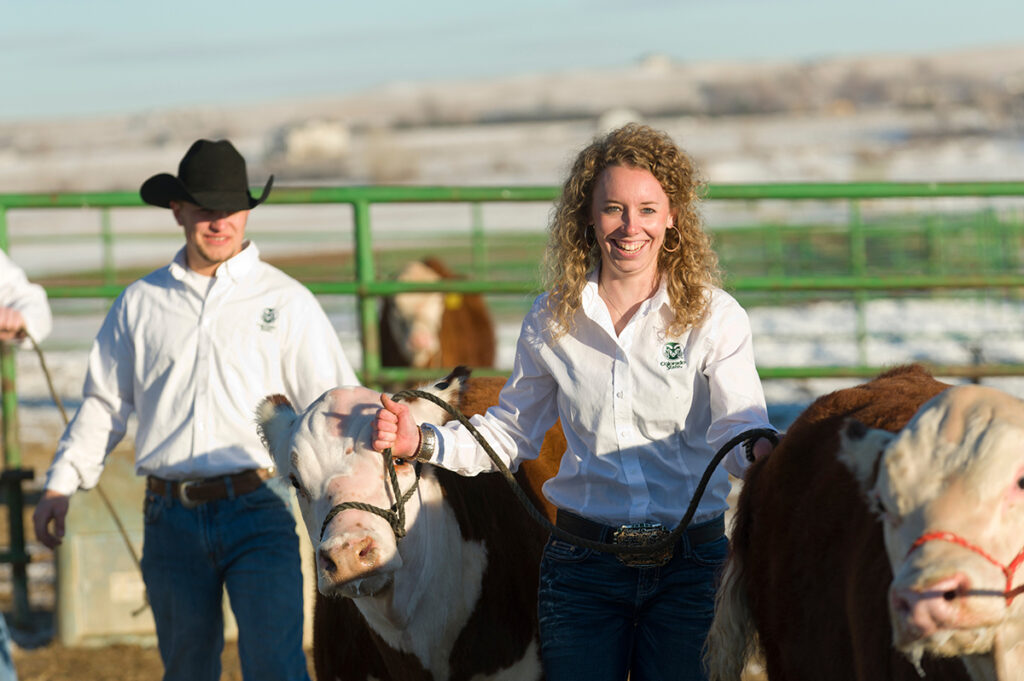
Erin Karney, a CSU alumna and sixth-generation cattle rancher, was recently appointed executive vice president of the Colorado Cattlemen’s Association, the top organization representing Colorado’s powerhouse cattle industry and its public policy concerns. The association is a partner of CSU Spur. She will be the first woman to head the association staff in its 155-year history. Karney will succeed Terry Fankhauser. Since 2015, she has worked as the association’s director of industry advancement. Karney graduated from Colorado State University in 2012 with bachelor’s degrees in animal science and agricultural business; she then earned a master’s degree in meat science in 2014. While at CSU, she was a member of a national champion meat-judging team and the Seedstock Merchandising Team. Karney grew up on a farm and ranch in Las Animas, in the Arkansas Valley of southeastern Colorado. Her family continues to ranch there, and Karney has her own herd of Angus crossbred cattle as part of the operation. She soon will help the Colorado Cattlemen’s Association move its offices into the Livestock Exchange Building, becoming a neighbor of CSU Spur at the National Western Center.
Photo at top: Janie VanWinkle is a Colorado State University alumna and past president of the Colorado Cattlemen’s Association. She shares knowledge about food production and helped envision activities at the National Western Center in Denver. “See Jane Ranch” is the name of one of her Facebook accounts, which she uses to offer insights about ranch life. Photo: Devon Balet
SHARE
